Limitations of a Multispectral UAV Sensor for Satellite Validation and Mapping Complex Vegetation
Abstract
:1. Introduction
2. Materials and Methods
2.1. Study Area
2.2. MicaSense Altum Data Acquisition
2.3. Ancillary Data Acquisition (Quality Assurance for Earth Observation Protocol)
2.3.1. Mjolnir VS-620 Hyperspectral Imagery
2.3.2. SPN1 Pyranometer Measurements and Insta360 Hemispherical Photographs
2.3.3. Spectroradiometer Panel Measurements
2.3.4. Satellite Imagery
2.4. Analysis
2.4.1. Diffuse Skylight Error Estimation
2.4.2. Reflectance Product of Standard Workflow
2.4.3. Reflectance Product Using Independent Corrections
2.4.4. Geospatial Offset Calculation
2.4.5. Determination and Comparison of Targets
2.4.6. Comparison of Peatland Vegetation Targets
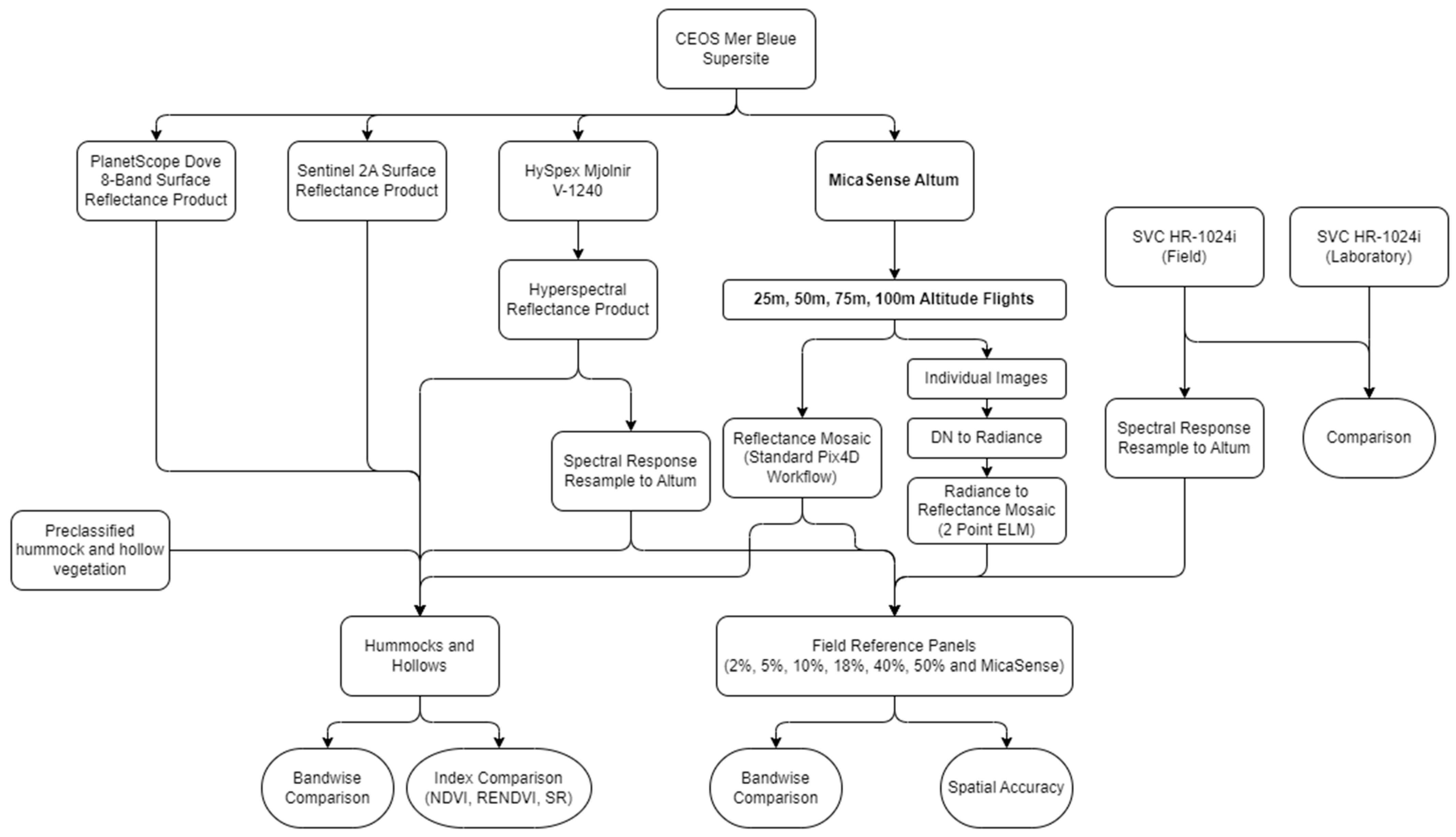
3. Results
3.1. Contribution of Operator Proximity to Reflectance Measurement
3.2. Spectroradiometer Panel Spectra and Hyperspectral Panel Spectra
3.3. Altum Panel Measurements
3.4. Altum Spatial Accuracy
3.5. Comparison of Vegetation Targets
4. Discussion
4.1. Calibration and Assessments of Multispectral Sensor Performance
4.2. Satellite Validation of Vegetation Using UAV Multi/Hyper Spectral
4.3. Overall Considerations and Future Work
5. Conclusions
Author Contributions
Funding
Data Availability Statement
Acknowledgments
Conflicts of Interest
References
- de Castro, A.I.; Shi, Y.; Maja, J.M.; Peña, J.M. UAVs for Vegetation Monitoring: Overview and Recent Scientific Contributions. Remote Sens. 2021, 13, 2139. [Google Scholar] [CrossRef]
- Fraser, R.H.; Olthof, I.; Lantz, T.C.; Schmitt, C. UAV Photogrammetry for Mapping Vegetation in the Low-Arctic. Arct. Sci. 2016, 2, 79–102. [Google Scholar] [CrossRef]
- Feng, Q.; Liu, J.; Gong, J. UAV Remote Sensing for Urban Vegetation Mapping Using Random Forest and Texture Analysis. Remote Sens. 2015, 7, 1074–1094. [Google Scholar] [CrossRef]
- Yao, H.; Qin, R.; Chen, X. Unmanned Aerial Vehicle for Remote Sensing Applications—A Review. Remote Sens. 2019, 11, 1443. [Google Scholar] [CrossRef]
- King, D.J. Airborne Multispectral Digital Camera and Video Sensors: A Critical Review of System Designs and Applications. Can. J. Remote Sens. 1995, 21, 245–273. [Google Scholar] [CrossRef]
- Deng, L.; Mao, Z.; Li, X.; Hu, Z.; Duan, F.; Yan, Y. UAV-Based Multispectral Remote Sensing for Precision Agriculture: A Comparison between Different Cameras. ISPRS J. Photogramm. Remote Sens. 2018, 146, 124–136. [Google Scholar] [CrossRef]
- Abdollahnejad, A.; Panagiotidis, D. Tree Species Classification and Health Status Assessment for a Mixed Broadleaf-Conifer Forest with UAS Multispectral Imaging. Remote Sens. 2020, 12, 3722. [Google Scholar] [CrossRef]
- Šedina, J.; Housarová, E.; Raeva, P. Using RPAS for the Detection of Archaeological Objects Using Multispectral and Thermal Imaging. Eur. J. Remote Sens. 2019, 52, 182–191. [Google Scholar] [CrossRef]
- Lynch, P.; Blesius, L.; Hines, E. Classification of Urban Area Using Multispectral Indices for Urban Planning. Remote Sens. 2020, 12, 2503. [Google Scholar] [CrossRef]
- Soffer, R.J.; Ifimov, G.; Arroyo-Mora, J.P.; Kalacska, M. Validation of Airborne Hyperspectral Imagery from Laboratory Panel Characterization to Image Quality Assessment: Implications for an Arctic Peatland Surrogate Simulation Site. Can. J. Remote Sens. 2019, 45, 476–508. [Google Scholar] [CrossRef]
- Cao, H.; Gu, X.; Wei, X.; Yu, T.; Zhang, H. Lookup Table Approach for Radiometric Calibration of Miniaturized Multispectral Camera Mounted on an Unmanned Aerial Vehicle. Remote Sens. 2020, 12, 4012. [Google Scholar] [CrossRef]
- Guo, Y.; Senthilnath, J.; Wu, W.; Zhang, X.; Zeng, Z.; Huang, H. Radiometric Calibration for Multispectral Camera of Different Imaging Conditions Mounted on a UAV Platform. Sustainability 2019, 11, 978. [Google Scholar] [CrossRef]
- Aasen, H.; Honkavaara, E.; Lucieer, A.; Zarco-Tejada, P.J. Quantitative Remote Sensing at Ultra-High Resolution with UAV Spectroscopy: A Review of Sensor Technology, Measurement Procedures, and Data Correction Workflows. Remote Sens. 2018, 10, 1091. [Google Scholar] [CrossRef]
- Honkavaara, E.; Saari, H.; Kaivosoja, J.; Pölönen, I.; Hakala, T.; Litkey, P.; Mäkynen, J.; Pesonen, L. Processing and Assessment of Spectrometric, Stereoscopic Imagery Collected Using a Lightweight UAV Spectral Camera for Precision Agriculture. Remote Sens. 2013, 5, 5006–5039. [Google Scholar] [CrossRef]
- Cao, S.; Danielson, B.; Clare, S.; Koenig, S.; Campos-Vargas, C.; Sanchez-Azofeifa, A. Radiometric Calibration Assessments for UAS-Borne Multispectral Cameras: Laboratory and Field Protocols. ISPRS J. Photogramm. Remote Sens. 2019, 149, 132–145. [Google Scholar] [CrossRef]
- Hakala, T.; Markelin, L.; Honkavaara, E.; Scott, B.; Theocharous, T.; Nevalainen, O.; Näsi, R.; Suomalainen, J.; Viljanen, N.; Greenwell, C.; et al. Direct Reflectance Measurements from Drones: Sensor Absolute Radiometric Calibration and System Tests for Forest Reflectance Characterization. Sensors 2018, 18, 1417. [Google Scholar] [CrossRef] [PubMed]
- Arroyo-Mora, J.P.; Kalacska, M.; Soffer, R.; Ifimov, G.; Leblanc, G.; Schaaf, E.S.; Lucanus, O. Evaluation of Phenospectral Dynamics with Sentinel-2A Using a Bottom-up Approach in a Northern Ombrotrophic Peatland. Remote Sens. Environ. 2018, 216, 544–560. [Google Scholar] [CrossRef]
- Loew, A.; Bell, W.; Brocca, L.; Bulgin, C.E.; Burdanowitz, J.; Calbet, X.; Donner, R.V.; Ghent, D.; Gruber, A.; Kaminski, T.; et al. Validation Practices for Satellite-Based Earth Observation Data across Communities. Rev. Geophys. 2017, 55, 779–817. [Google Scholar] [CrossRef]
- Wu, X.; Xiao, Q.; Wen, J.; You, D.; Hueni, A. Advances in Quantitative Remote Sensing Product Validation: Overview and Current Status. Earth-Sci. Rev. 2019, 196, 102875. [Google Scholar] [CrossRef]
- Wang, C. At-Sensor Radiometric Correction of a Multispectral Camera (RedEdge) for sUAS Vegetation Mapping. Sensors 2021, 21, 8224. [Google Scholar] [CrossRef]
- Mamaghani, B.; Salvaggio, C. Multispectral Sensor Calibration and Characterization for sUAS Remote Sensing. Sensors 2019, 19, 4453. [Google Scholar] [CrossRef]
- Gokool, S.; Mahomed, M.; Brewer, K.; Naiken, V.; Clulow, A.; Sibanda, M.; Mabhaudhi, T. Crop Mapping in Smallholder Farms Using Unmanned Aerial Vehicle Imagery and Geospatial Cloud Computing Infrastructure. Heliyon 2024, 10, e26913. [Google Scholar] [CrossRef] [PubMed]
- Martínez-Peña, R.; Vélez, S.; Vacas, R.; Martín, H.; Álvarez, S. Remote Sensing for Sustainable Pistachio Cultivation and Improved Quality Traits Evaluation through Thermal and Non-Thermal UAV Vegetation Indices. Appl. Sci. 2023, 13, 7716. [Google Scholar] [CrossRef]
- Buunk, T.; Vélez, S.; Ariza-Sentís, M.; Valente, J. Comparing Nadir and Oblique Thermal Imagery in UAV-Based 3D Crop Water Stress Index Applications for Precision Viticulture with LiDAR Validation. Sensors 2023, 23, 8625. [Google Scholar] [CrossRef]
- Yu, F.; Bai, J.; Jin, Z.; Guo, Z.; Yang, J.; Chen, C. Combining the Critical Nitrogen Concentration and Machine Learning Algorithms to Estimate Nitrogen Deficiency in Rice from UAV Hyperspectral Data. J. Integr. Agric. 2023, 22, 1216–1229. [Google Scholar] [CrossRef]
- Chancia, R.; Bates, T.; Vanden Heuvel, J.; van Aardt, J. Assessing Grapevine Nutrient Status from Unmanned Aerial System (UAS) Hyperspectral Imagery. Remote Sens. 2021, 13, 4489. [Google Scholar] [CrossRef]
- Zhang, X.; Han, L.; Dong, Y.; Shi, Y.; Huang, W.; Han, L.; González-Moreno, P.; Ma, H.; Ye, H.; Sobeih, T. A Deep Learning-Based Approach for Automated Yellow Rust Disease Detection from High-Resolution Hyperspectral UAV Images. Remote Sens. 2019, 11, 1554. [Google Scholar] [CrossRef]
- Kuswidiyanto, L.W.; Noh, H.-H.; Han, X. Plant Disease Diagnosis Using Deep Learning Based on Aerial Hyperspectral Images: A Review. Remote Sens. 2022, 14, 6031. [Google Scholar] [CrossRef]
- Lafleur, P.M.; Roulet, N.T.; Bubier, J.L.; Frolking, S.; Moore, T.R. Interannual Variability in the Peatland-Atmosphere Carbon Dioxide Exchange at an Ombrotrophic Bog. Glob. Biogeochem. Cycles 2003, 17. [Google Scholar] [CrossRef]
- Strachan, I.B.; Pelletier, L.; Bonneville, M.-C. Inter-Annual Variability in Water Table Depth Controls Net Ecosystem Carbon Dioxide Exchange in a Boreal Bog. Biogeochemistry 2016, 127, 99–111. [Google Scholar] [CrossRef]
- Lafleur, P.M.; Roulet, N.T.; Admiral, S.W. Annual Cycle of CO2 Exchange at a Bog Peatland. J. Geophys. Res. Atmos. 2001, 106, 3071–3081. [Google Scholar] [CrossRef]
- Malhotra, A.; Roulet, N.T.; Wilson, P.; Giroux-Bougard, X.; Harris, L.I. Ecohydrological Feedbacks in Peatlands: An Empirical Test of the Relationship among Vegetation, Microtopography and Water Table. Ecohydrology 2016, 9, 1346–1357. [Google Scholar] [CrossRef]
- CEOS Land Product Validation Subgroup. Available online: https://lpvs.gsfc.nasa.gov/LPV_Supersites/LPVsites.html (accessed on 26 March 2024).
- Eppinga, M.B.; Rietkerk, M.; Borren, W.; Lapshina, E.D.; Bleuten, W.; Wassen, M.J. Regular Surface Patterning of Peatlands: Confronting Theory with Field Data. Ecosystems 2008, 11, 520–536. [Google Scholar] [CrossRef]
- Kalacska, M.; Arroyo-Mora, J.P.; Soffer, R.J.; Roulet, N.T.; Moore, T.R.; Humphreys, E.; Leblanc, G.; Lucanus, O.; Inamdar, D. Estimating Peatland Water Table Depth and Net Ecosystem Exchange: A Comparison between Satellite and Airborne Imagery. Remote Sens. 2018, 10, 687. [Google Scholar] [CrossRef]
- User Guide for MicaSense Sensors. Available online: https://support.micasense.com/hc/en-us/articles/360039671254-User-Guide-for-MicaSense-Sensors (accessed on 12 May 2023).
- Niro, F.; Goryl, P.; Dransfeld, S.; Boccia, V.; Gascon, F.; Adams, J.; Themann, B.; Scifoni, S.; Doxani, G. European Space Agency (ESA) Calibration/Validation Strategy for Optical Land-Imaging Satellites and Pathway towards Interoperability. Remote Sens. 2021, 13, 3003. [Google Scholar] [CrossRef]
- Arroyo-Mora, J.P.; Kalacska, M.; Soffer, R.J.; Lucanus, O. Comparison of Calibration Panels from Field Spectroscopy and UAV Hyperspectral Imagery Acquired Under Diffuse Illumination. In Proceedings of the 2021 IEEE International Geoscience and Remote Sensing Symposium IGARSS, Brussels, Belgium, 11–16 July 2021; pp. 60–63. [Google Scholar]
- Soffer, R.; Arroyo-Mora, J.P.; Kalacska, M.; Ifimov, G.; Leblanc, G. Mer Bleue QA4EO Airborne Hyperspectral Imagery. Borealis, V1. 2022. Available online: https://borealisdata.ca/dataset.xhtml?persistentId=doi:10.5683/SP3/RMGOIW (accessed on 11 May 2023).
- Koirala, P.; Løke, T.; Baarstad, I.; Fridman, A.; Hernandez, J. Real-Time Hyperspectral Image Processing for UAV Applications, Using HySpex Mjolnir-1024. Proc. SPIE 2017, 10198, 64–74. [Google Scholar] [CrossRef]
- ISPRS-Archives-Drone Data Atmospheric Correction Concept for Multi- and Hyperspectral Imagery–The DROACOR Model. Available online: https://isprs-archives.copernicus.org/articles/XLIII-B3-2020/473/2020/ (accessed on 11 May 2023).
- Milton, E.J.; Schaepman, M.E.; Anderson, K.; Kneubühler, M.; Fox, N. Progress in Field Spectroscopy. Remote Sens. Environ. 2009, 113, S92–S109. [Google Scholar] [CrossRef]
- Elmer, K.; Soffer, R.J.; Arroyo-Mora, J.P.; Kalacska, M. ASDToolkit: A Novel MATLAB Processing Toolbox for ASD Field Spectroscopy Data. Data 2020, 5, 96. [Google Scholar] [CrossRef]
- PySpectra/PySpectra at Master · Pmlrsg/PySpectra · GitHub. Available online: https://github.com/pmlrsg/PySpectra/tree/master/PySpectra (accessed on 9 May 2024).
- Open Access Hub. Available online: https://scihub.copernicus.eu/ (accessed on 23 May 2023).
- Understanding PlanetScope Instruments. Available online: https://developers.planet.com/docs/apis/data/sensors/ (accessed on 23 May 2023).
- PlanetScope ESA Archive-Earth Online. Available online: https://earth.esa.int/eogateway/catalog/planetscope-esa-archive (accessed on 23 May 2023).
- Soffer, R. Contamination of Ground Spectral Measurements Due to Operator Proximity. Session WE3.09: Calibration and Validation and standards in support of Spaceborne Imaging Spectroscopy Missions I, Paper 4152. In Proceedings of the IEEE Geoscience And Remote Sensing Society 2014/35th Canadian Symposium for Remote Ssensing, Quebec City, QC, Canada, 13–18 July 2014. [Google Scholar]
- GitHub—Micasense/Imageprocessing: MicaSense RedEdge and Altum Image Processing Tutorials. Available online: https://github.com/micasense/imageprocessing (accessed on 11 May 2024).
- ExifTool by Phil Harvey. Available online: https://exiftool.org/ (accessed on 23 May 2023).
- Xue, J.; Su, B. Significant Remote Sensing Vegetation Indices: A Review of Developments and Applications. J. Sens. 2017, 2017, e1353691. [Google Scholar] [CrossRef]
- Kalacska, M.; Lucanus, O.; Arroyo-Mora, J.P.; Laliberté, É.; Elmer, K.; Leblanc, G.; Groves, A. Accuracy of 3D Landscape Reconstruction without Ground Control Points Using Different UAS Platforms. Drones 2020, 4, 13. [Google Scholar] [CrossRef]
- Hutton, J.J.; Lipa, G.; Baustian, D.; Sulik, J.; Bruce, R.W. high accuracy direct georeferencing of the altum multi-spectral uav camera and its application to high throughput plant phenotyping. Int. Arch. Photogramm. Remote Sens. Spat. Inf. Sci. 2020, XLIII-B1-2020, 451–456. [Google Scholar] [CrossRef]
- Best Practices: Collecting Data with MicaSense Sensors–MicaSense Knowledge Base. Available online: https://support.micasense.com/hc/en-us/articles/224893167-Best-practices-Collecting-Data-with-MicaSense-Sensors (accessed on 15 April 2024).
- Spectral Characteristics Viewer|Landsat Missions. Available online: https://landsat.usgs.gov/spectral-characteristics-viewer (accessed on 15 April 2024).
- Daniels, L.; Eeckhout, E.; Wieme, J.; Dejaegher, Y.; Audenaert, K.; Maes, W.H. Identifying the Optimal Radiometric Calibration Method for UAV-Based Multispectral Imaging. Remote Sens. 2023, 15, 2909. [Google Scholar] [CrossRef]
- Poncet, A.M.; Knappenberger, T.; Brodbeck, C.; Fogle, M.; Shaw, J.N.; Ortiz, B.V. Multispectral UAS Data Accuracy for Different Radiometric Calibration Methods. Remote Sens. 2019, 11, 1917. [Google Scholar] [CrossRef]
- Zarzar, C.; Dash, P.; Dyer, J.; Moorhead, R.; Hathcock, L. Development of a Simplified Radiometric Calibration Framework for Water-Based and Rapid Deployment Unmanned Aerial System (UAS) Operations. Drones 2020, 4, 17. [Google Scholar] [CrossRef]
- Tu, Y.-H.; Phinn, S.; Johansen, K.; Robson, A. Assessing Radiometric Correction Approaches for Multi-Spectral UAS Imagery for Horticultural Applications. Remote Sens. 2018, 10, 1684. [Google Scholar] [CrossRef]
- Assmann, J.J.; Kerby, J.T.; Cunliffe, A.M.; Myers-Smith, I.H. Vegetation Monitoring Using Multispectral Sensors—Best Practices and Lessons Learned from High Latitudes. J. Unmanned Veh. Sys. 2019, 7, 54–75. [Google Scholar] [CrossRef]
- Inamdar, D.; Kalacska, M.; Leblanc, G.; Arroyo-Mora, J.P. Characterizing and Mitigating Sensor Generated Spatial Correlations in Airborne Hyperspectral Imaging Data. Remote Sens. 2020, 12, 641. [Google Scholar] [CrossRef]
- Inamdar, D.; Kalacska, M.; Darko, P.O.; Arroyo-Mora, J.P.; Leblanc, G. Spatial Response Resampling (SR2): Accounting for the Spatial Point Spread Function in Hyperspectral Image Resampling. Methods X 2023, 10, 101998. [Google Scholar] [CrossRef] [PubMed]
- Slade, G.; Fawcett, D.; Cunliffe, A.M.; Brazier, R.E.; Nyaupane, K.; Mauritz, M.; Vargas, S.; Anderson, K. Optical Reflectance across Spatial Scales—An Intercomparison of Transect-Based Hyperspectral, Drone, and Satellite Reflectance Data for Dry Season Rangeland. Drone Syst. Appl. 2023, 11, 1–20. [Google Scholar] [CrossRef]
- Messina, G.; Peña, J.M.; Vizzari, M.; Modica, G. A Comparison of UAV and Satellites Multispectral Imagery in Monitoring Onion Crop. An Application in the ‘Cipolla Rossa Di Tropea’ (Italy). Remote Sens. 2020, 12, 3424. [Google Scholar] [CrossRef]
- Jain, K.; Pandey, A. Calibration of Satellite Imagery with Multispectral UAV Imagery. J. Indian Soc. Remote Sens. 2021, 49, 479–490. [Google Scholar] [CrossRef]
- Ihuoma, S.O.; Madramootoo, C.A.; Kalacska, M. Integration of Satellite Imagery and in Situ Soil Moisture Data for Estimating Irrigation Water Requirements. Int. J. Appl. Earth Obs. Geoinf. 2021, 102, 102396. [Google Scholar] [CrossRef]
- Gago, J.; Douthe, C.; Coopman, R.E.; Gallego, P.P.; Ribas-Carbo, M.; Flexas, J.; Escalona, J.; Medrano, H. UAVs Challenge to Assess Water Stress for Sustainable Agriculture. Agric. Water Manag. 2015, 153, 9–19. [Google Scholar] [CrossRef]
- Zarco-Tejada, P.J.; González-Dugo, V.; Berni, J.A.J. Fluorescence, Temperature and Narrow-Band Indices Acquired from a UAV Platform for Water Stress Detection Using a Micro-Hyperspectral Imager and a Thermal Camera. Remote Sens. Environ. 2012, 117, 322–337. [Google Scholar] [CrossRef]
- Turner, D.; Lucieer, A.; Watson, C. An Automated Technique for Generating Georectified Mosaics from Ultra-High Resolution Unmanned Aerial Vehicle (UAV) Imagery, Based on Structure from Motion (SfM) Point Clouds. Remote Sens. 2012, 4, 1392–1410. [Google Scholar] [CrossRef]
- Khaliq, A.; Comba, L.; Biglia, A.; Ricauda Aimonino, D.; Chiaberge, M.; Gay, P. Comparison of Satellite and UAV-Based Multispectral Imagery for Vineyard Variability Assessment. Remote Sens. 2019, 11, 436. [Google Scholar] [CrossRef]
- Burns, B.W.; Green, V.S.; Hashem, A.A.; Massey, J.H.; Shew, A.M.; Adviento-Borbe, M.A.A.; Milad, M. Determining Nitrogen Deficiencies for Maize Using Various Remote Sensing Indices. Precis. Agric. 2022, 23, 791–811. [Google Scholar] [CrossRef]
- Olson, D.; Anderson, J. Review on Unmanned Aerial Vehicles, Remote Sensors, Imagery Processing, and Their Applications in Agriculture. Agron. J. 2021, 113, 971–992. [Google Scholar] [CrossRef]
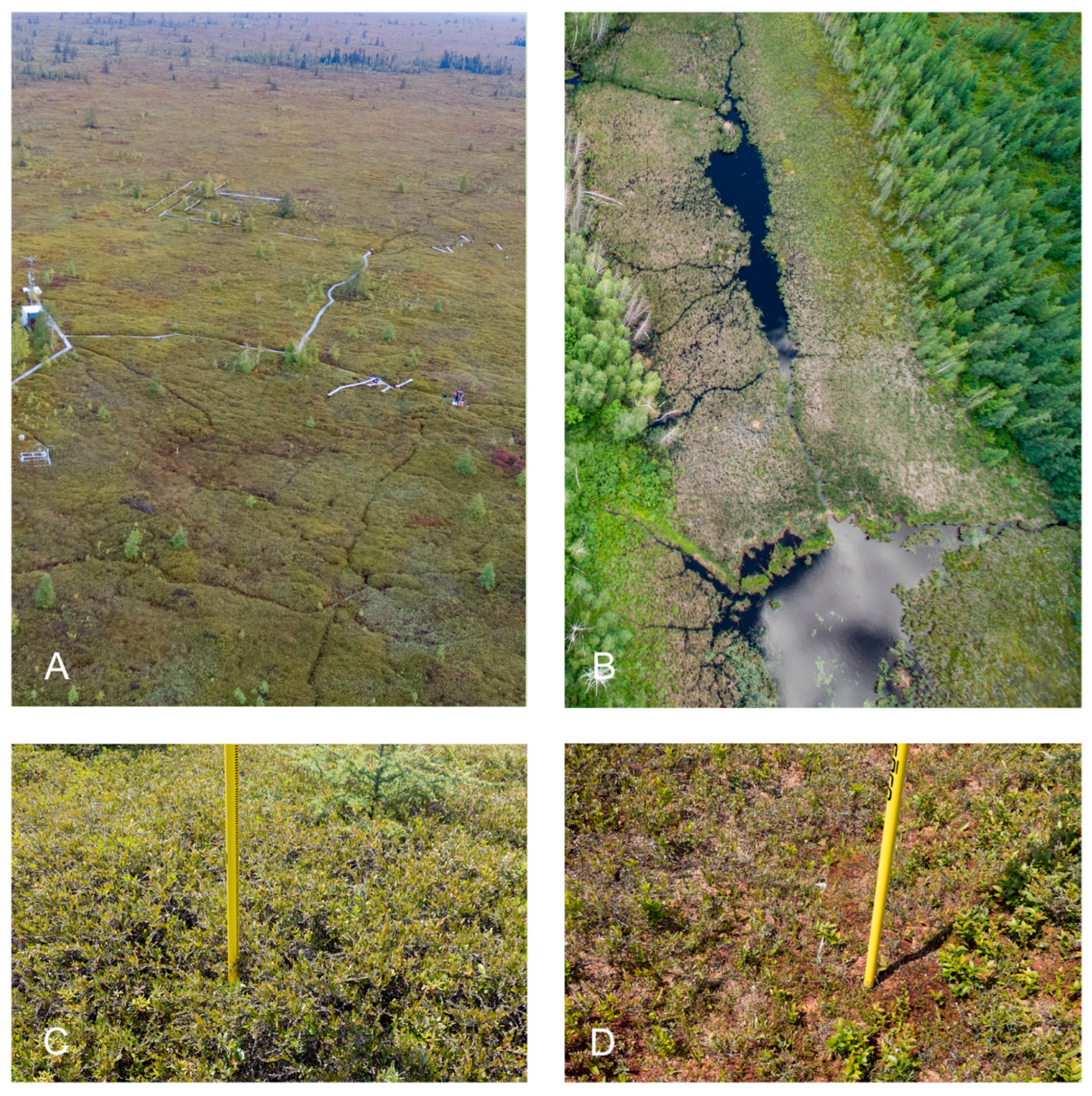

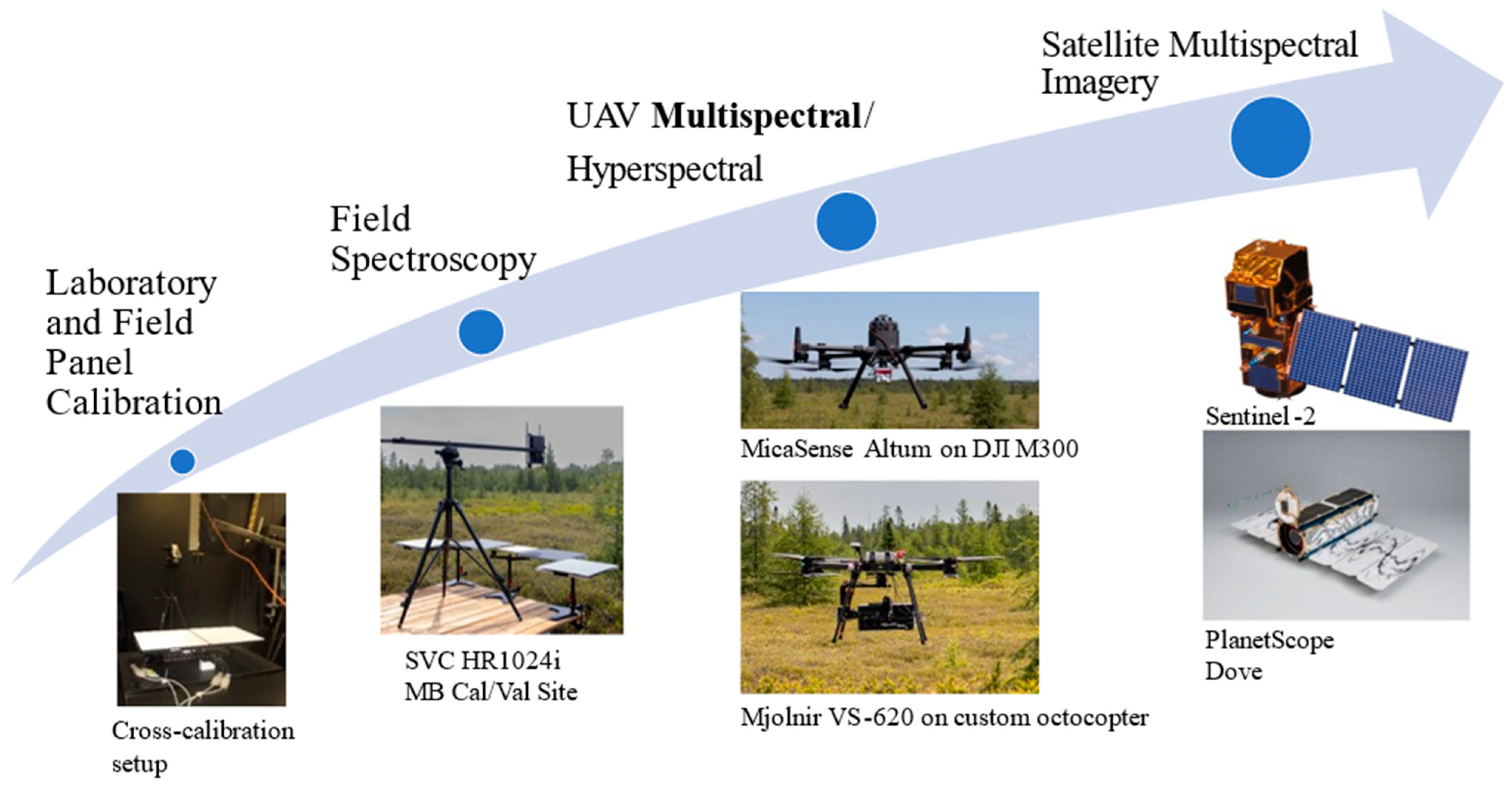


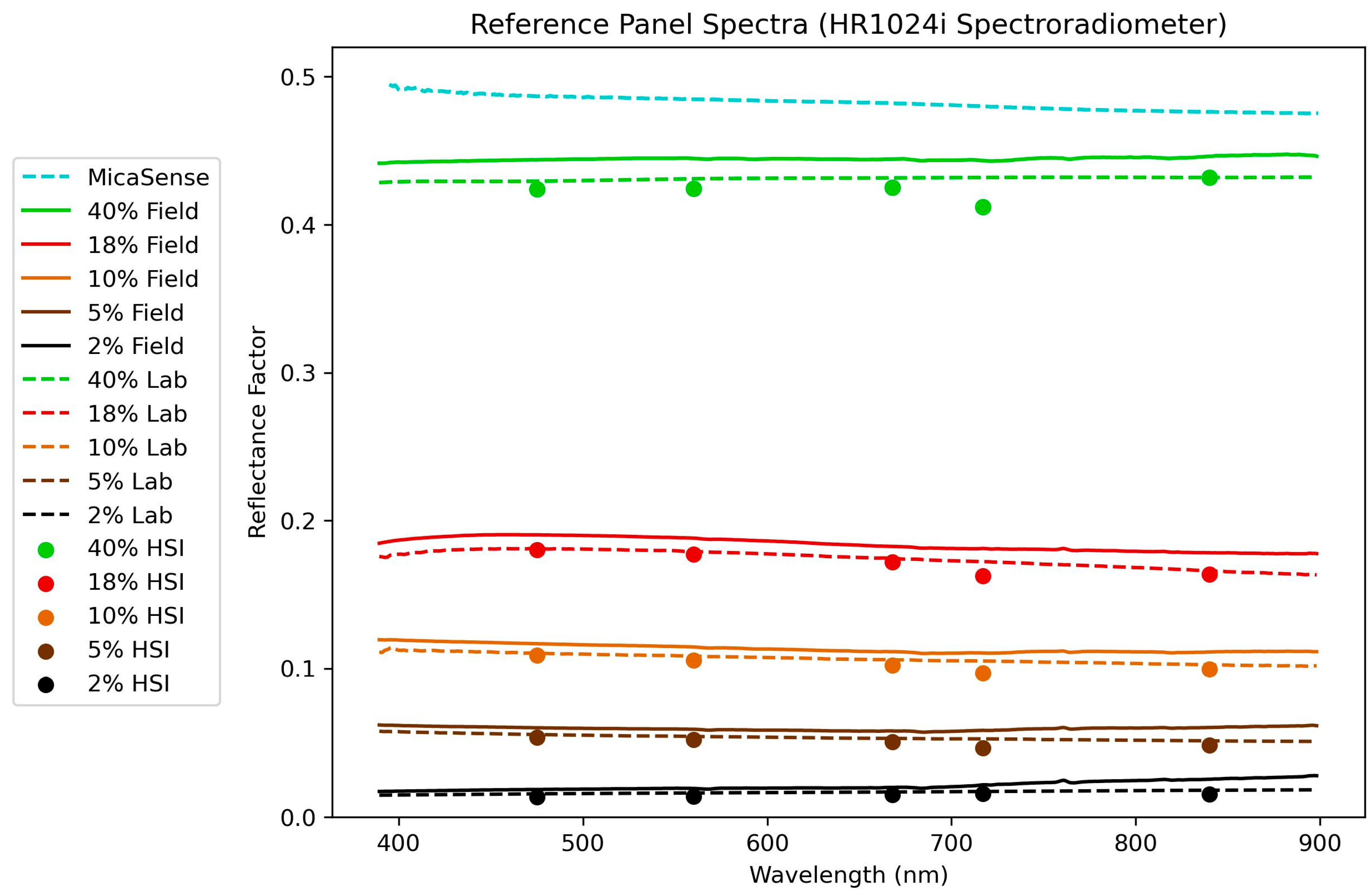

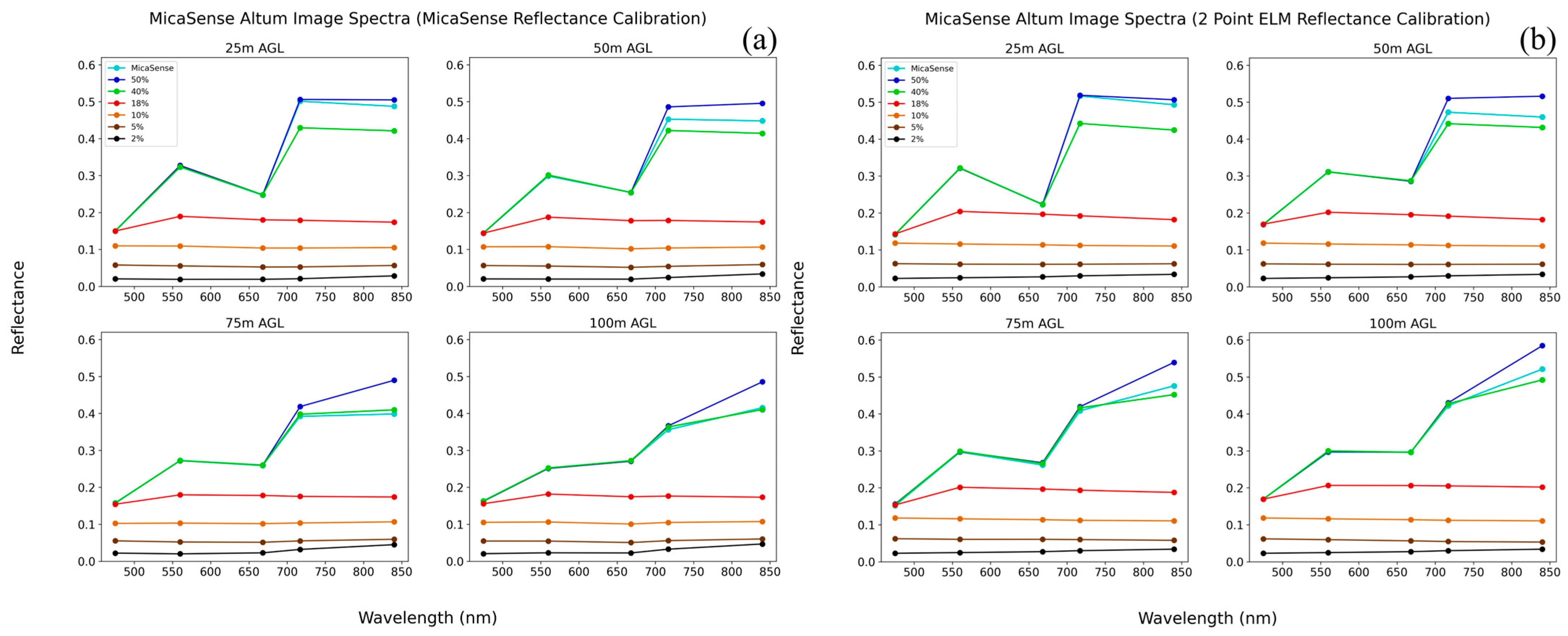
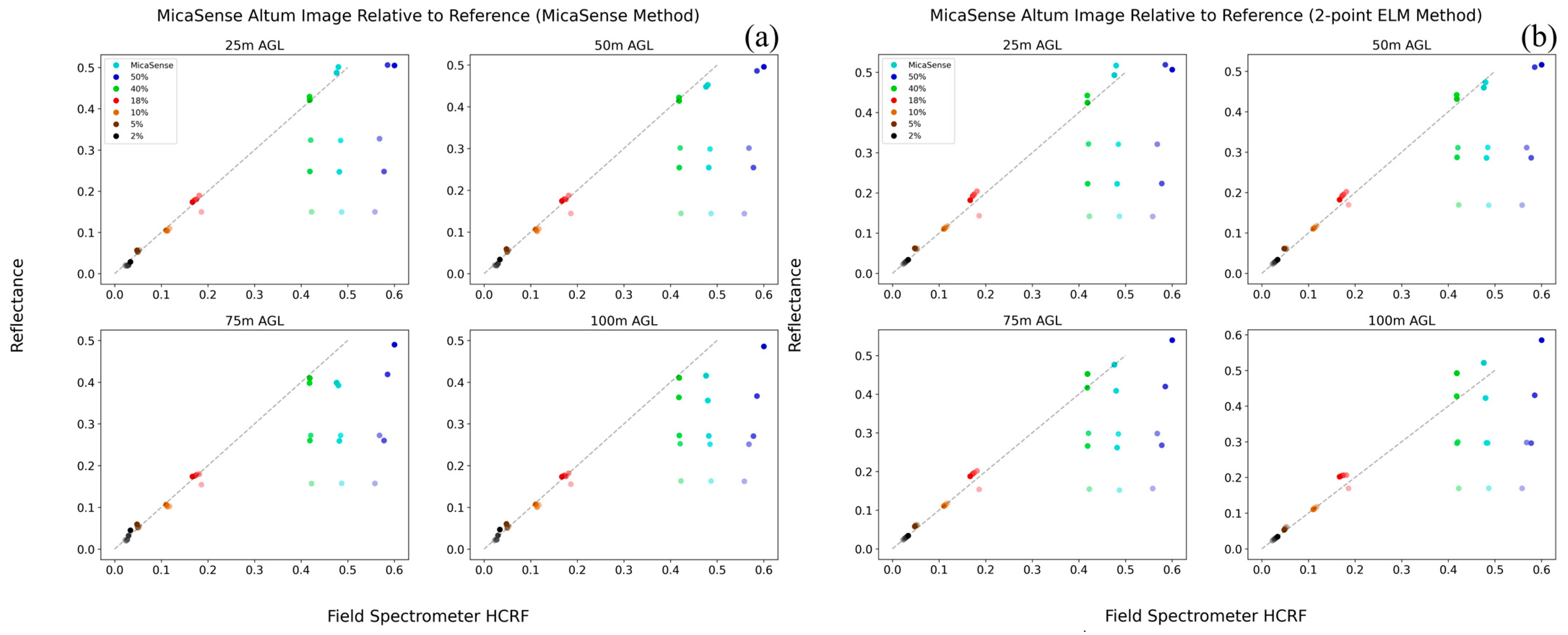

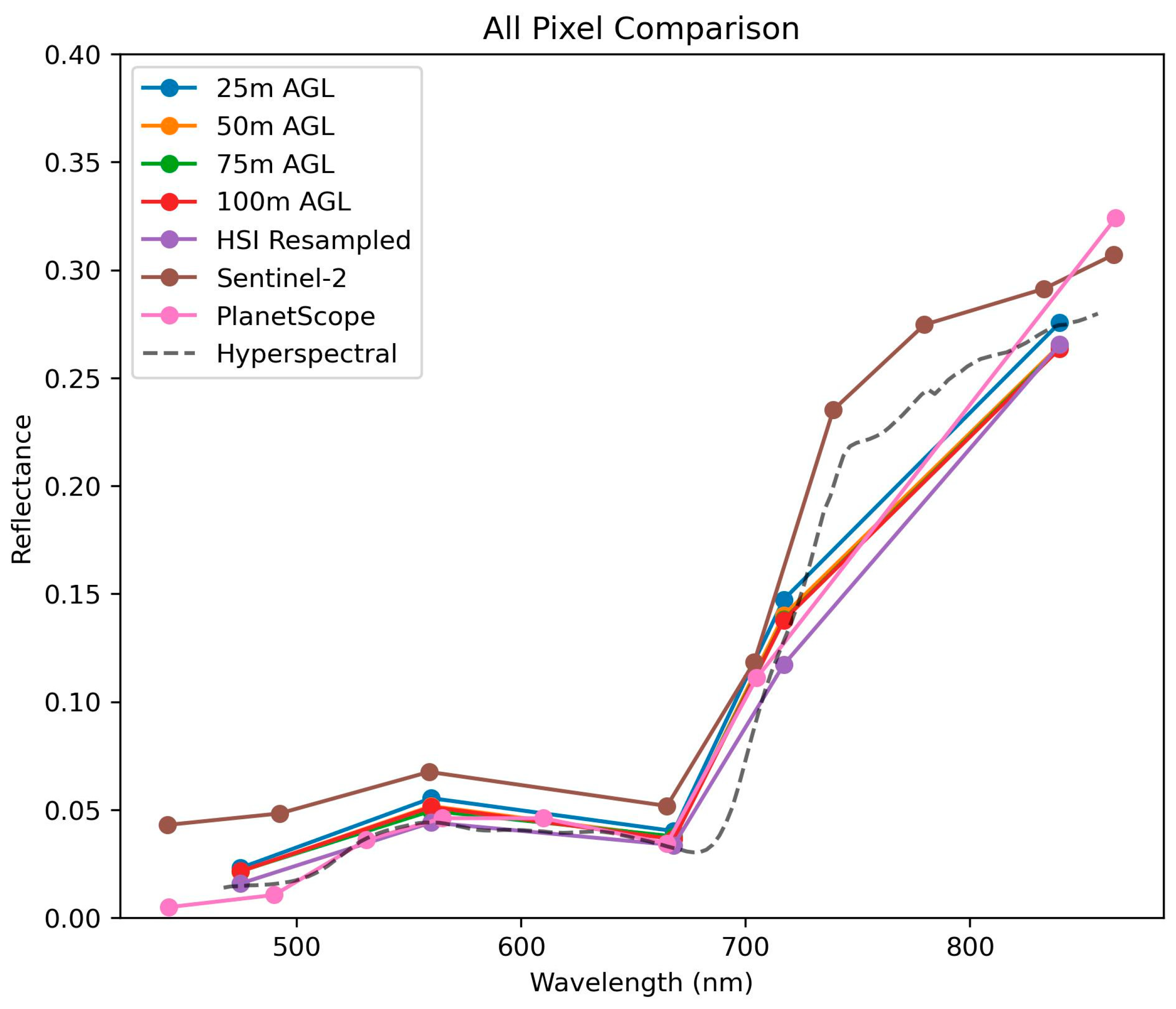
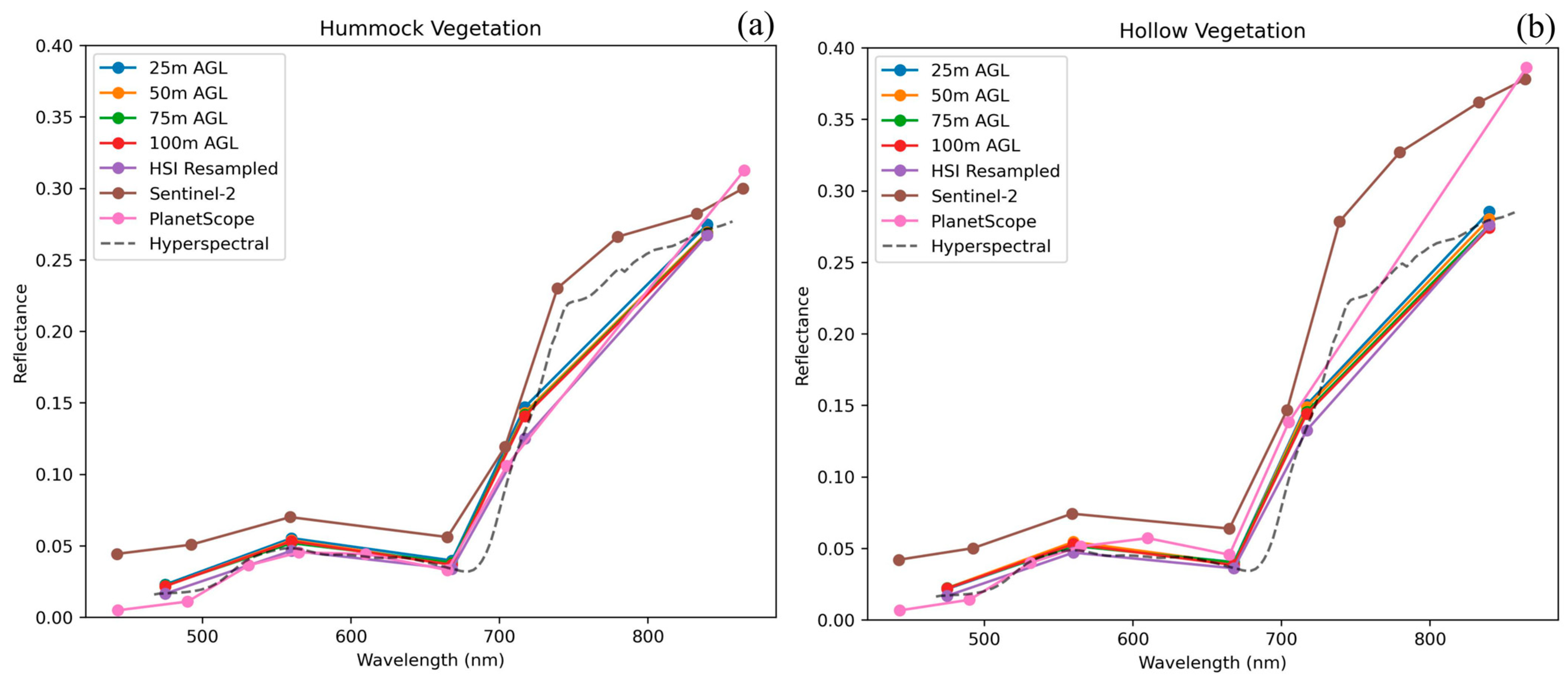

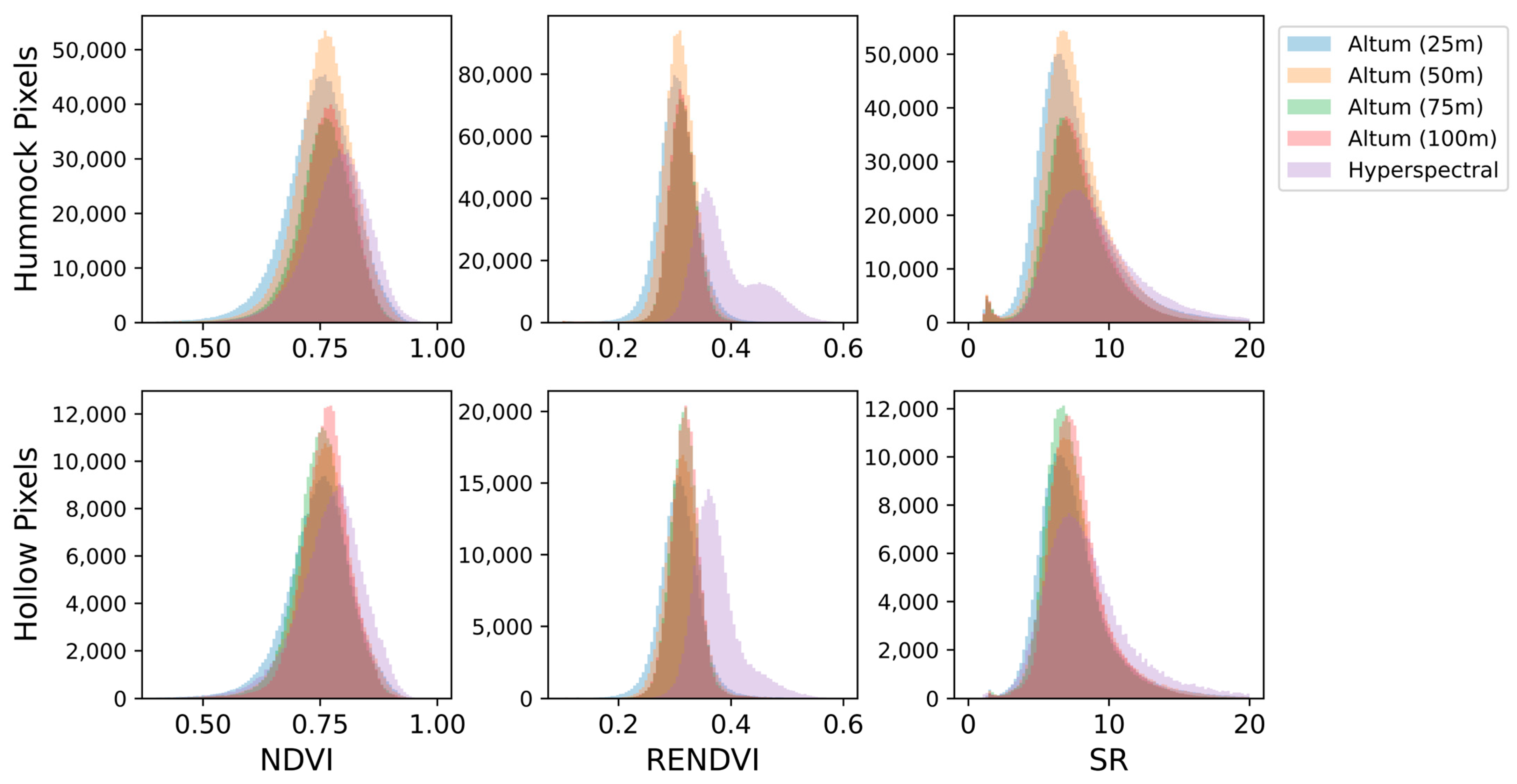


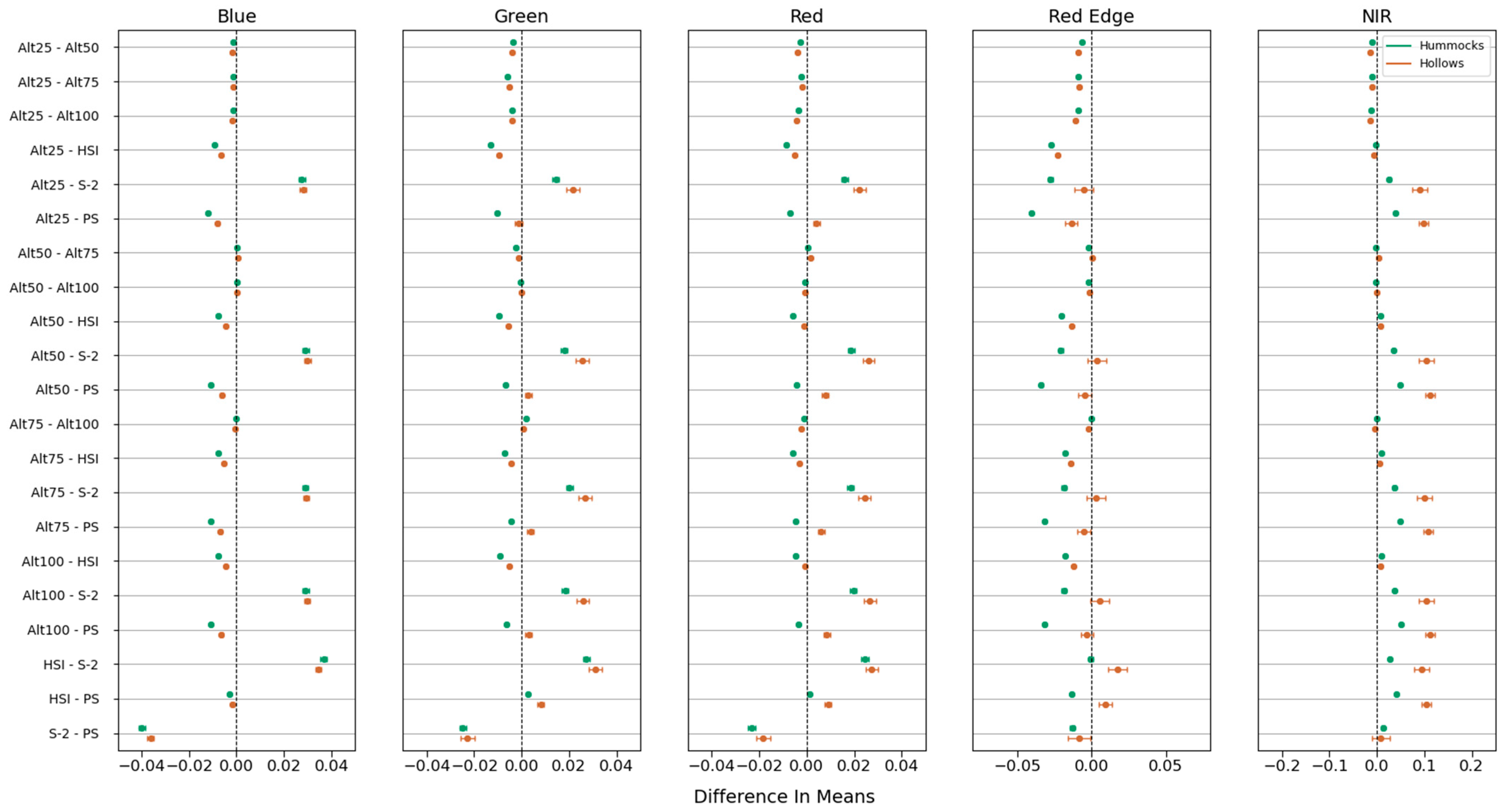
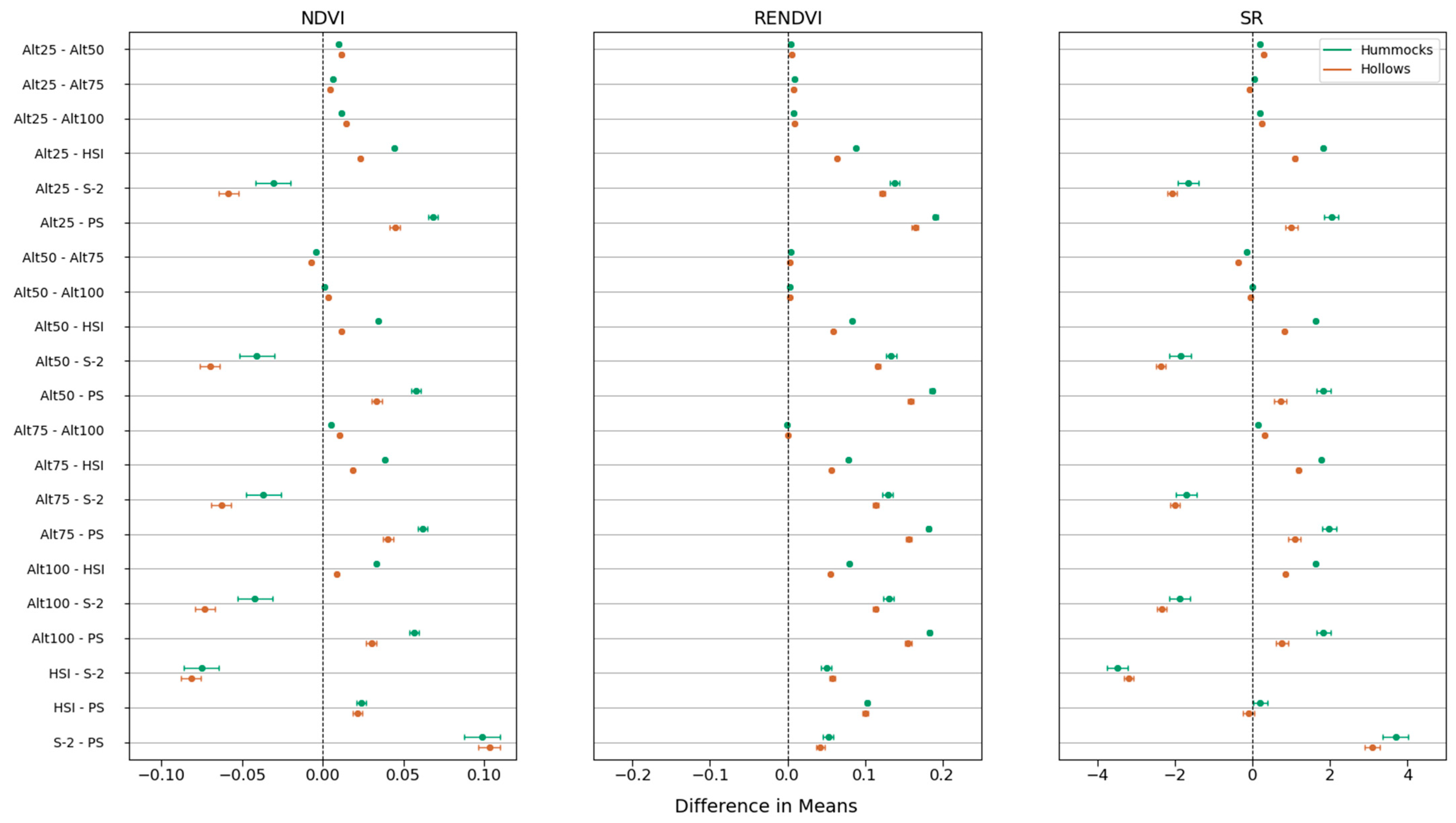
| Characteristic | Value |
|---|---|
| Pixel Size | 3.45 um |
| Bands (FWHM) | 475 nm (32) 560 nm (27) 668 nm (16) 717 nm (12) 842 nm (57) |
| Resolution | 2064 × 1544 px (3.2 MP × 5 sensors) |
| Aspect Ratio | 4:3 |
| Sensor Size | 7.12 × 5.33 mm (8.9 mm diagonal) |
| Focal Length | 8 mm |
| Field of view (h × v) | 48° × 36.8° |
| Intrinsic bit depth (DNG) | 12-bit |
| Output bit depth (TIFF) | 16-bit |
| GSD @ 120 m (~400 ft) | 5.2 cm |
| GSD @ 60 m (~200 ft) | 2.1 cm |
| Altitude | Time | Speed | Area Covered | No. Images | Ground Sample Distance (GSD) |
|---|---|---|---|---|---|
| 25 m | 5 min | ~3.2 m/s | 0.7 ha | 925 | 1.14 cm |
| 50 m | 3 min | ~5 m/s | 1.5 ha | 462 | 2.24 cm |
| 75 m | 3 min 25 s | ~5 m/s | 2.5 ha | 456 | 3.36 cm |
| 100 m | 1 min 47 s | ~5 m/s | 3.6 ha | 600 | 4.40 cm |
| Characteristic | V-1240 |
|---|---|
| Spectral range | 400–1000 nm |
| Spatial pixels | 1240 |
| Spectral channels and sampling interval | 200 bands @ 3.0 nm |
| F-number | f1.8 |
| FOV | 20° |
| IFOV across/along track | 0.27/0.54 mrad |
| Bit resolution | 12-bit |
| Noise floor | 2.37 e− |
| Dynamic range | 4400 |
| Characteristic | Value |
|---|---|
| Spectral Range | 350 nm–2500 nm |
| Spectral Resolution (FWHM) | 3.3 nm, 700 nm 9.5 nm, 1500 nm 6.5 nm, 2100 nm |
| Sampling Interval | ≤1.5 nm, 350–1000 nm ≤3.8 nm, 1000–1890 nm ≤2.5 nm, 1890–2500 nm |
| Sentinel 2 | PlanetScope Super Dove | ||||||
|---|---|---|---|---|---|---|---|
| Band Number * | Band Center (nm) | FWHM (nm) | Pixel Size (m) | Band Number | Band Center (nm) | FWHM (nm) | Pixel Size (m) |
| 1 | 442.7 | 21 | 60 | 1 | 443.0 | 20 | 3 |
| 2 | 492.4 | 66 | 10 | 2 | 490.0 | 50 | 3 |
| 3 | 559.8 | 36 | 10 | 3 | 531.0 | 36 | 3 |
| 4 | 664.6 | 31 | 10 | 4 | 565.0 | 36 | 3 |
| 5 | 704.1 | 15 | 20 | 5 | 610.0 | 20 | 3 |
| 6 | 740.5 | 15 | 20 | 6 | 665.0 | 31 | 3 |
| 7 | 782.8 | 20 | 20 | 7 | 705 | 15 | 3 |
| 8 | 832.8 | 106 | 10 | 8 | 864 | 40 | 3 |
| 8a | 864.7 | 21 | 20 | ||||
| Data Source | Pixel Size (m) | Hummock (px) | Hollow (px) |
|---|---|---|---|
| 25m AGL | 0.01 | 8,797,704 | 1,678,710 |
| 50m AGL | 0.02 | 2,258,812 | 434,734 |
| 75m AGL | 0.03 | 1,010,971 | 195,918 |
| 100m AGL | 0.04 | 588,828 | 115,210 |
| Mjolnir V-1240 | 0.03 | 1,261,831 | 231,995 |
| Sentinel 2 ** | 10 | 313 | 51 |
| PlanetScope ** | 3 | 586 | 228 |
Disclaimer/Publisher’s Note: The statements, opinions and data contained in all publications are solely those of the individual author(s) and contributor(s) and not of MDPI and/or the editor(s). MDPI and/or the editor(s) disclaim responsibility for any injury to people or property resulting from any ideas, methods, instructions or products referred to in the content. |
© 2024 by the authors. Licensee MDPI, Basel, Switzerland. This article is an open access article distributed under the terms and conditions of the Creative Commons Attribution (CC BY) license (https://creativecommons.org/licenses/by/4.0/).
Share and Cite
Cottrell, B.; Kalacska, M.; Arroyo-Mora, J.-P.; Lucanus, O.; Inamdar, D.; Løke, T.; Soffer, R.J. Limitations of a Multispectral UAV Sensor for Satellite Validation and Mapping Complex Vegetation. Remote Sens. 2024, 16, 2463. https://doi.org/10.3390/rs16132463
Cottrell B, Kalacska M, Arroyo-Mora J-P, Lucanus O, Inamdar D, Løke T, Soffer RJ. Limitations of a Multispectral UAV Sensor for Satellite Validation and Mapping Complex Vegetation. Remote Sensing. 2024; 16(13):2463. https://doi.org/10.3390/rs16132463
Chicago/Turabian StyleCottrell, Brendan, Margaret Kalacska, Juan-Pablo Arroyo-Mora, Oliver Lucanus, Deep Inamdar, Trond Løke, and Raymond J. Soffer. 2024. "Limitations of a Multispectral UAV Sensor for Satellite Validation and Mapping Complex Vegetation" Remote Sensing 16, no. 13: 2463. https://doi.org/10.3390/rs16132463





